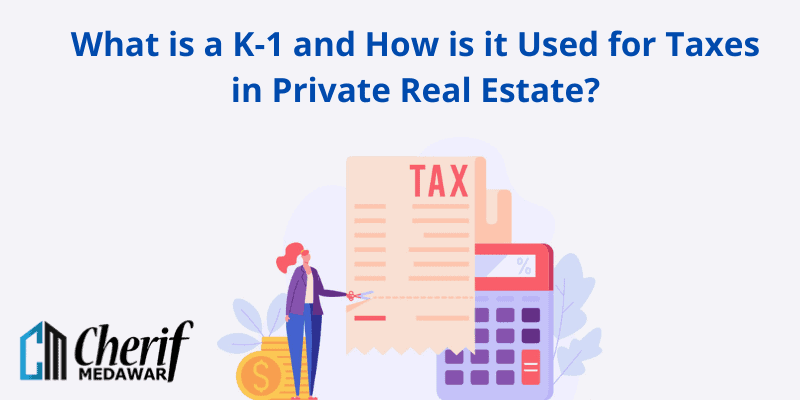A K-1 form is a tax form used to report the incomes, losses, and dividends of a business’s partners or an S corporation’s shareholders. K-1 forms are issued by partnerships, S corporations, estates, and trusts.
The recipient of the income, loss, or dividend is responsible for reporting it on their federal tax return. Investors in hedge funds, private equity funds and real estate funds receive K-1 forms if they own interests in pass-through entities, such as partnerships.
A K-1 is a tax form used by pass-through entities, including partnerships, S corporations and limited liability companies (LLCs). The form reports the income and losses of a business to its individual owners.
Private real estate investors have many choices when it comes to investing, but there are several factors that make real estate investing unique. One of these is the K-1 filing for tax purposes.
A K-1 is a form that must be filed along with your income tax return if you are invested in a pass-through entity, like a limited liability company or partnership. The form shows how much income you’ve earned from the investment and what types of deductions you can take.
The first thing that you need to know about the K-1 form is that it is not the same as a 1099. A K-1 form is used to report your share of income, deductions, and credits from a partnership, S corporation, trust, or estate.
Important K-1 and Tax Filing Information for Private Real Estate Investors
Valuation
When filing taxes, it’s essential to know the value of your investment at the end of each year. Private real estate funds provide both an estimated valuation at the end of each month as well as a final valuation at the end of each year.
The value of the investment at year end may not be the same as the amount reported on the K-1 statement. The amount reported on the K-1 is the “book value” of the asset(s). The book value is typically the price paid for an asset adjusted for capital improvements made during ownership and depreciation taken since acquisition.
Because private real estate transactions are complex and vary from property to property, it is not uncommon for there to be delays between when revenue is collected and when expenses are processed.
Tax Basis
Your tax basis is defined by your initial investment amount into a fund plus any additional capital contributions you’ve made over the course of your investment minus any distributions you’ve received during your holding period.
Each investor’s initial investment in the partnership is recorded as their tax basis for the investment. Any additional capital contributions increase the investor’s basis in the partnership. Any distributions from a partnership reduce the tax basis dollar for dollar up to the amount invested in the partnership. If a distribution exceeds a partner’s initial investment, the excess distribution reduces any gain recognized if and when the partner disposes of his or her interest in the partnership.
Losses
When filing taxes as a private real estate investor, losses can be used to offset other income from sources such as wages or stock dividends. But if your losses exceed $3,000 or so in any tax year — depending on your filing status and income — you may have to carry over some of those losses into future years. To do this, first use all losses against other income in the year they arise; then carry over any unused portion to next year’s tax return; and finally use that remaining amount against other income in that second year.
Tax Deferred Distributions
Many private real estate funds will offer investors the opportunity to postpone (defer) the recognition of taxable income by reinvesting distributions in additional units or shares of the fund’s interest under a so-called “distribution reinvestment plan” (DRIP). This is advantageous because it allows investors to avoid current taxation on the distributions and instead defer taxation until the eventual disposition of the investment. Additionally, investors may be eligible for long-term capital gains treatment when they do eventually sell their investment.
K-1 Arrivals
If you are a passive investor in private real estate funds (either directly or through a 1031 exchange), you will be receiving a K-1 form for each fund in which you hold an interest.
Once you have received your K-1 forms, please be sure to follow the below steps: Check that the Box 17 codes accurately reflect the tax treatment of your investment.
Be aware that certain Box 17 codes may require additional information on your tax return to be properly treated. Be sure to discuss these with your tax advisor.
Consult your tax advisor regarding any amendments to the underlying partnership agreements that may have occurred during the year. These changes could affect your allocation of income and/or basis, and may require additional actions on your part.
Multiple Forms
Some shareholders may receive several K-1s from different real estate investment entities. This can raise multiple questions for investors about how to best file their taxes. It’s important for investors to remember that a K-1 form is attached to each entity that you have invested in during that calendar year. With multiple K-1s in hand, it is also important to remember that each form must be submitted with its own tax return — there can be no bundling of multiple K-1s on a single tax return.
Let’s say you have investments in multiple partnerships. Each partnership is required to generate their own K-1s, which means you could potentially have numerous forms to file and track. Keep in mind that each partnership is required to send out their K-1s by March 15th or April 15th at the latest (or soon after).*
Composite Returns
If you invest through a partnership or LLC, you may have noticed that most fund managers offer Composite Returns so that investors do not have to pay state income taxes on investor distributions.
A composite return is a state tax return filed by an “agent” on behalf of two or more non-resident individuals. The agent computes the income earned by all non-residents, determines the appropriate state tax liability, and pays that amount to the taxing state. The agent then issues each investor a composite annual statement that discloses the investor’s share of the income taxed and paid on their behalf. The individual investors still must file their own state tax returns in their resident states. However, they do not have to pay any additional tax since it was paid by the agent on their behalf.
Conclusion
The new tax law allows for one new way to be a real estate professional, but only one. If it is your intention to qualify as a real estate professional in the eyes of the IRS… be careful that you do not plan, invest, or operate outside of those rules.
Learn the Steps to Invest in Commercial Real Estate Like a PRO by becoming a part of Cherif Medawar’s Commercial Real Estate Mastermind


